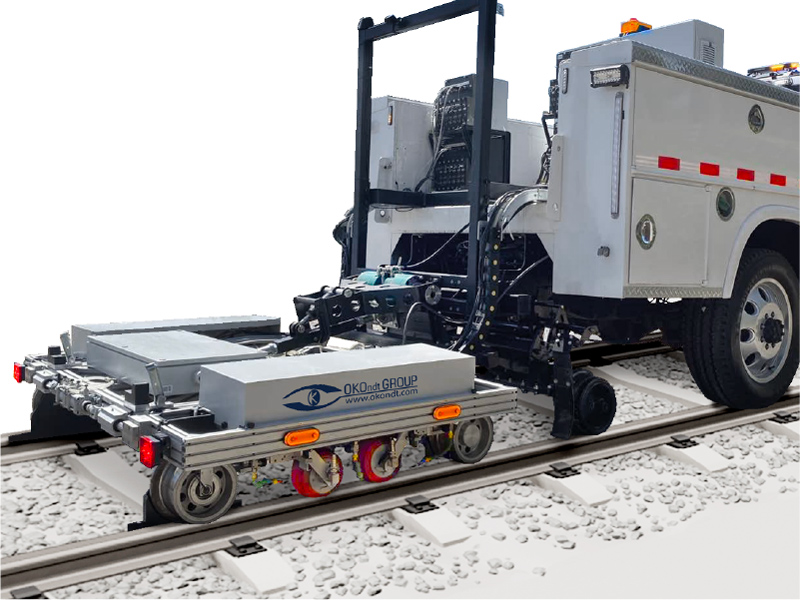
OKOSCAN UT 73HS PICKUP is a high-speed ultrasonic testing system for rails with testing speed of up to 40 km/h (24.85 mph) which is installed onto the customer`s vehicle (based on Ford F350 XL (SUPER DUTY) with combined course car.
The safety and reliability of rail transport depend largely on the condition of the tracks. Defects that develop in rails during operation, including those caused by wear, corrosion, repeated load cycles, and various mechanical impacts, can progress from minor to significant and eventually become critical. These critical defects may result in rail breakage under a moving train, so they require immediate attention. Therefore, it is essential to regularly inspect the tracks using ultrasonic high-speed rail testing Systems. These Systems can detect all types of rail defects at different stages of development according to AREMA, EN 16729-1, and UIC 712-R norms. They can also determine the geolocation and depth of the occurrence of defects. This allows for timely repair or replacement of rails before defects reach a critical stage and threaten operational safety.

OKOSCAN UT 73HS PICKUP is a high-speed ultrasonic testing system for rails with testing speed of up to 40 km/h (24.85 mph) which is installed onto the customer`s vehicle (based on Ford F350 XL (SUPER DUTY) with combined course car.
High-speed ultrasonic (UT) rail testing Systems are installed on hi-rail vehicles, inspection trains, and self-propelled inspection cars. These testing machines provide rapid rail flaw detection for railroads and metro lines. While in motion at operating speeds, they scan both rails and welds of the track and collect data on their condition.
Ultrasonic immersion probe units, which are installed on the rail-mounted testing trolley, automatically transmit signals to the software of the railway inspection System. Built-in algorithms in this software analyze the data, detect potential rail defects and their geolocation, and send appropriate different signals to the NDT technician. This automated signal processing minimizes human influence on the outcome of the inspection and improves the effectiveness of detecting defects in rails.
High-speed test Systems integrated with vehicles are especially effective for nondestructive testing (NDT) during inspections of extended and heavily used rail tracks. If necessary, the vehicle carrying the rail flaw detection System can exit the tracks at any crossing to allow a train to pass. Then, it can drive back and continue the ultrasonic rail inspection.
The NDT Technician's workplace and the electronics of the System are located inside the vehicle body, enabling UT inspections in any weather condition.
One of the most cost-effective and easy-to-maintain rail track inspection Systems is one integrated into a hi-rail vehicle, such as a pickup truck or a box truck.
Integrating high-speed ultrasonic testing Systems into railroad inspection machines, trains, and trucks allows for the systematic identification of critical rail defects in railway tracks and metro lines. This process also promotes the prediction of defect progression and the timely elimination of such defects.
OKOndt GROUP invites companies interested in advanced hi-rail vehicles equipped with hi-speed rail flaw detection systems to collaborate. Contact us for expert advice on selecting the most suitable NDT solution for your railway inspection needs.
OKOndt GROUP is a group of companies with more than 30 years of experience in researching, developing, and producing nondestructive testing (NDT) equipment for industrial customers worldwide. The production companies in the group are Ultracon-Service LLC and Promprylad LLC.
Need help?